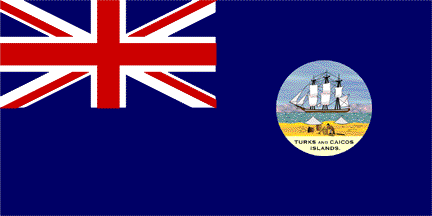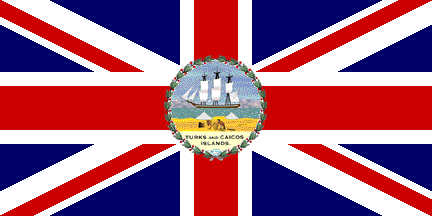
This page is part of © FOTW Flags Of The World website
Turks and Caicos - Historical Flags
Last modified: 2003-07-18 by dov gutterman
Keywords: turks and caicos | jamaica | bahamas | conch | crayfish | america | caribbean | shell | lobster | cactus | pelican | sisal |
Links: FOTW homepage |
search |
disclaimer and copyright |
write us |
mirrors
See also:
Previous Flag

1875-1889
by Martin Grieve, 7 July 2003

1889-1968
by Jaume Olle', 21 March 2000
I have a drawing of the
Turks and Caicos Islands flag that was granted to them before
1904 and was replaced by the current one in 1968. It consists of
the Blue British Ensign with a circular badge in the fly.
This badge contains a seescape with a navigating ship as
background and a beach. In the beach there is a men, I do
not know, what is he doing, but it seems he is cooking something
over a fire. A boat over the beach is seen too. I have gotten it
from the "Enciclopedia Bruguera" and from the
"Diccionario Latinoamericano"
Juan Manuel Gabino Villasca'n, 7 March 2000
Illustration of this flag appears in p. 108 (bottom) at [zna99], with two rows of three Blue
Ensigns each. In the second row there is "Turks & Caicos
Islands (end of XIXth century - 1968)".
Ivan Sache, 25 Febuary 2001
Governor Flag

1875-1923
by Martin Grieve, 7 July 2003
Whilst checking this I found that the Union Jack defaced with
the Turks & Caicos 1875 badge was cancelled 22 September
1923. [National Archives (PRO) ADM 116/1847B].
David Prothero, 9 July 2003
Turks and Caicos Hitorical Badges
1875.gif)
1875-1889
by Martin Grieve, 2 July 2003
based on illustration in 1881 booklet: 'Arms or Badges of the
several Colonies of Great Britain'
The circular badge on the first flag was introduced sometime before 1904. The arms were granted 28 September 1965 and the shield from the arms replaced the circular badge on the flag in 1968.
The administrative sequence was:
Until 1959 the T&C were a dependency of Jamaica; in 1959 the
T&C became a separate colony but until 1962 the Governor of
Jamaica was also the Governor of T&C. Between 1962 and 1965
the Administrator of the T&C reported directly to London.
Between 1965 and 1973 the Administrator was subordinate to the
Governor of the Bahamas who was also Governor of the T&C. In
1973 when Bahamas became independent the Administrator was
up-graded to Governor.
The old circular badge is the answer to a sneaky quiz
question: 'what tropical island used to have an igloo on it's
flag?' The two white semi-circles in the foreground are supposed
to be piles of salt raked up on the salt-pans, but the heraldic
artist who drew the seal thought they were meant to be buildings
and put a door-way in one making it look like an igloo.
David Prothero, 30 July 1997
Turks/Caicos and the Cayman Islands were dependencies of
Jamaica. Turks had its own badge based on the Seal of the colony
from 1875 until 1958 when it was replaced by the current shield
David Prothero, 22 November 1999
Turks Islands, settled from Bermuda in 1678 , were too dry for
the cultivation of sugar cane, and pans were created in which
seawater was evaporated to make salt. This was shipped to
the cod-fisheries of North America for use as a
preservative. The Caicos Islands were settled about a
hundred years later by American loyalists. In 1799 both
settlements were annexed to Bahamas, but in 1848 became a
separate presidency under the Governor of Jamaica.
14 September 1869 - Turks Islands were included in the list of
colonies required to submit a sketch of the proposed badge of the
colony. This was probably an error. Other
presidencies such as Virgin Islands or St Kitts Nevis had no
badge until after the Leeward Islands were unbundled in
1956. Similarly a dependency, which Turks and Caicos became
in 1874, should not have had its own badge. Seychelles, a
dependency of Mauritius, had no badge until it became a separate
colony in 1903.
12 January 1870 - President Melfort Campbell sent Sir P.Grant,
Governor of Jamaica: " ... a sketch of a Union Jack with the
arms of this colony in the centre - the arms being similar to
those of the public seal.
2. I can not recommend the adoption of these arms as the
expense of emblazoning them on the standards would be excessive,
and I think some simple device could well be substituted (such as
a crescent and star on a blue ground) but the Executive Council
are of opinion that the central
badge on the standard should correspond with the seal of the
colony.
3. Some explanation of the badge may be requisite : the
foreground represents salt heaps with measures and raking
implement, and an individual filling one of the measures with
salt. In the background is a vessel ready for her freight
of the staple commodity of this colony."
The despatch was forwarded to Earl Granville, the Secretary of
State in London. He replied, "I concur with
Mr.Campbell in thinking that the arms of this colony are too
elaborate to be placed on a flag, and that the design he proposed
would be much preferable, but if after this expression of my
opinion the Legislature still desire to retain the badge they
have chosen, I shall not withhold my sanction to their doing
so."
The Executive Council adhered to their previous conviction that
the Colony's Arms should form the central device on the flag used
by the Presidents, and a black and white drawing of the complete
seal, including royal arms, was adopted by the colony with the
approval of the Colonial Office and Admiralty in July 1870.
It was included in a draft sheet of colonial badges circulated by
the Colonial Office in September 1874. The Admiralty asked
if the Turks Islands' badge should be uncoloured. The query
was passed on to Turks Islands, now a Dependency of Jamaica, with
a Commissioner as head of government.
The Council had changed its mind, and on 16 January 1875
Mr.Commissioner Smith replied that, "In lieu of former
device proposed, think that crescent and three white stars on
blue would be suitable. Crescent emblematic of name of islands,
and three stars of the principle islands in the settlement; Grand
Turk, Salt Cay and Caicos Group."
Apparently he thought that the name of the islands was connected
with Ottoman Turks, but it is more likely that they were named
for an indigenous cactus (included on the current arms) similar
in shape to a decorative knot, which was called a Turks Head
because if its resemblance to a Turkish fez.
The Governor of Jamaica, now Sir W.Grey, forwarded Smith's
letter, adding: "I have the honor to state that I suggested
to the Commissioner that a simpler device should be selected for
the flag of Turks Islands than proposed in 1870, on the ground of
less expense that it would entail, and I have to report that the
suggestion has been adopted, and that a crescent and three stars,
white on a blue field, has been submitted as the device to be
emblazoned on the flag of these islands, which I may remark was
originally proposed by President Campbell in 1870."
However the Colonial Office now realised that the Order in
Council authorising the flags, required (in the absence of arms)
the use of the seal of the colony. The following was
written on a minute sheet. "Ref. Turks 17 February. Hasty in
approving device of Captain Campbell in 1870, which is like that
now submitted by Sir W.Grey. Seal without royal arms is all
that is wanted."
A despatch went back to Jamaica, resulting in a letter dated 25
March 1875 from Sir W.Grey to Turks. "Having reference to
terms of Order in Council of 7 August 1869 in Lord Granville's
Circular Despatch of 14 September, it appears on further
consideration desirable to follow practice in most colonies and
emblazon flag with distinctive part of seal of
colony. Only the distinctive panel required, not the
royal arms. Request fresh drawing."
In September the Colonial Office sent the Admiralty a drawing
similar to the one eventually published, adding, "If you
concur, words Turks and Caicos Islands, which appear on seal,
will be inserted under device and within wreath."
Admiralty replied; "Words should be inserted."
A final twist in the tale came when the badges from the 1881
Colonial Office book were re-drawn for publication in the
Admiralty Flag Book of 1889. The illustrator apparently
thought that the heaps of salt were really huts, or possibly even
igloos, and 'improved' the drawing by inserting a doorway into
one of the heaps.
[National Archives (PRO) CO 301/55 and CO 323/321].
Above is 1875' badge before it was 'improved' in 1889.
David Prothero, 2 July 2003